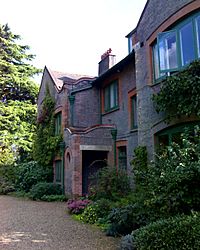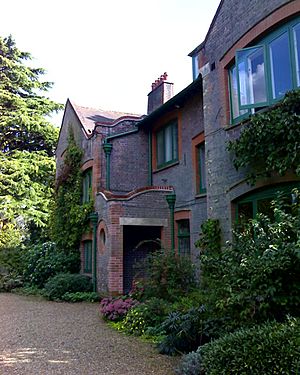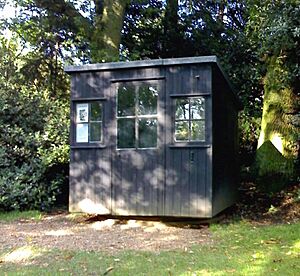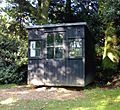Shaw's Corner facts for kids
Quick facts for kids Shaw's Corner |
|
|---|---|

The front of Shaw's Corner.
|
|
| Location | Ayot St Lawrence, near Welwyn Garden City, Hertfordshire, England, UK |
| Built | Early 20th century |
| Architect | Smee, Mence & Houchin |
| Architectural style(s) | Arts and Crafts movement |
| Governing body | National Trust |
|
Listed Building – Grade II*
|
|
| Official name: Shaw's Corner | |
| Designated | 24 January 1967 |
| Reference no. | 1348110 |
Shaw's Corner is a special house in the small village of Ayot St Lawrence, England. It was once the home of a very famous Irish writer named George Bernard Shaw. Today, it's a National Trust property, which means it's open for people to visit, like a museum about a writer's life.
When you visit, you can see the rooms just as Shaw left them. You can also explore the beautiful garden and even peek inside Shaw's unique writing hut. The house itself was built in the early 1900s. It has a lovely style called "Arts and Crafts," which focuses on handmade quality and natural materials. Shaw's Corner is located in Hertfordshire, about 6 miles from Welwyn Garden City.
Contents
Who Was George Bernard Shaw?
George Bernard Shaw was a brilliant writer from Ireland. He wrote many plays, and he was also a very important thinker. He won the Nobel Prize in Literature in 1925 for his amazing work. Shaw lived at Shaw's Corner from 1906 until he passed away in 1950.
The house was originally built in 1902 as a new rectory for the village. A rectory is a house where a church leader, like a rector, lives. However, the Church of England decided the house was too big for the village. So, they decided to rent it out instead.
Shaw and his wife, Charlotte Payne-Townshend, moved into the house in 1906. They loved it so much that they eventually bought it in 1920. They paid £6,220 for the house and its land. Later, they even bought more land from a friend, making the total property about 1.4 hectares (or 3.5 acres).
Shaw's Special Writing Hut
One of the most interesting parts of Shaw's Corner is his special writing hut. Shaw wrote many of his famous plays in this small, private space. It was built at the bottom of his garden.
This tiny hut was only about 64 square feet (or 6 square meters). What made it so special? It was built on a central steel pole with a circular track! This meant Shaw could rotate the hut to follow the sun throughout the day. This way, he always had the best light for writing.
Shaw had a funny nickname for his hut: "London." He would tell unwanted visitors that he was away "visiting the capital." This helped him get some peace and quiet to focus on his writing!
Shaw's Corner Today
After George Bernard Shaw and his wife passed away, their ashes were mixed together. They were then scattered along the footpaths and around a statue of Saint Joan in their garden at Shaw's Corner.
In 1967, Shaw's Corner was recognized as a very important historical building. It was given a "Grade II* listed building" status. This means it's a building of special interest and needs to be protected. Today, the National Trust takes care of Shaw's Corner. They make sure it stays just as Shaw left it, so visitors can learn about his life and work.
Gallery
See also
 In Spanish: Shaw's Corner para niños
In Spanish: Shaw's Corner para niños








